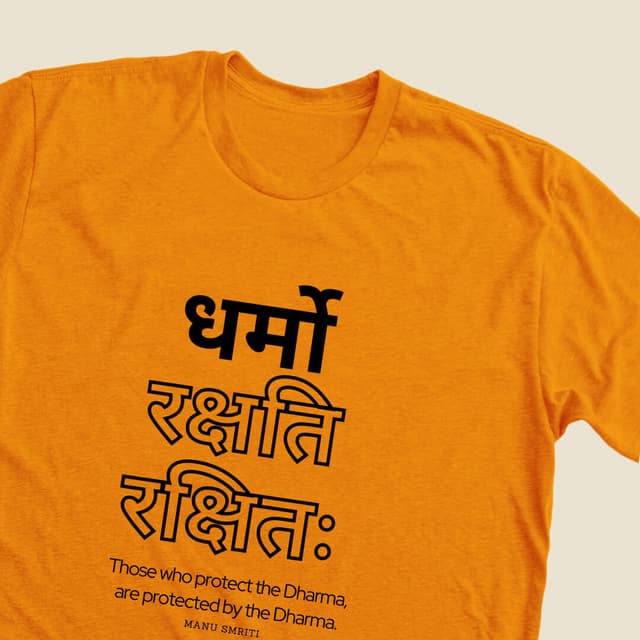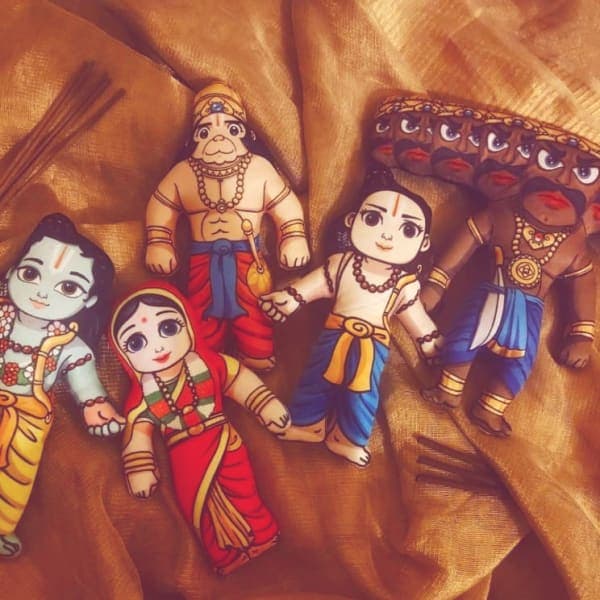Different Schools of Yoga
The article discusses the various schools of yoga, such as Hatha, Ashtanga, Kundalini, and Iyengar, and their unique characteristics, principles, and practices. It highlights the importance of finding the right style that aligns with one's goals and preferences and recommends exploring and experimenting with different schools to discover the most suitable one. The article also emphasizes the need for a dedicated and consistent practice to experience the physical, mental, and spiritual benefits of yoga.
Schools of Yoga
Yoga is the unique science of consciousness that deal with all important systems of human life from body to personality to mind and to the idea of self. According to ancient yogic scripture, yoga is a very subtle science that provides the union of individual consciousness to the universal consciousness and lets the practitioner remain in a state of bliss. Sage Patanjali was the first one who documented the yoga practices of that time, for future use of practitioners. Later on, many practitioners and yogis came & documented the different texts on yoga on the basis of their individual experiences. On the basis of different practices and teachings of Bhagavad Geeta, different schools of yoga have been introduced.
In last few decades, yoga has helped many people to improve their self-concept. Yoga realizes that man is not only mins but also the body as well. Just improving the condition of body does not necesserily improve it for mind because human being is not only the body and mind but the emotions and desires as well. He is beyong body and mind. Therefore yoga has been designed in such a way that it can complete the process of evolution of self-personality in all directions. That is why yoga has been contruded with so many branches and different techniques and ways to achieve the goal of yoga.
Raja Yoga is the practice that required austerity to follow. It consists of certain guidelines to follow and a set of different practices. This practice is made for the person who has a strong dedication and determination.
Jnana Yoga is the practice of knowledge and learning. Those who always keen to learn more and have curiosity about life and soul should follow the path of Knowledge or Jnana Yoga.
Bhakti yoga is made up of the strong emotion of a devotee. If a person loves to worship God and feels a relation of him with God then he or she should follow this path of Bhakti.
Karma yoga can be applied to householders. Who believes in good actions and the theory of karmas, who are willing to fulfill their responsibilities, and want to achieve liberation from the cycle of life and rebirth, should practice karma yoga.
- Raja Yoga
- Jnana Yoga
- Bhakti Yoga
- Karma Yoga
Raja Yoga
In Sanskrit, raja means ‘king”, and Raja Yoga meaning is “royal path” or the principal form of yoga. Raja Yoga considered being the science of mind. Instead of exploring the outer world like other sciences, raja yoga is concerned with exploring the inner world and unleashing the power and knowledge contained within. Raja Yoga includes specific guidelines and discipline to be followed by the practitioner that helps to achieve one-pointedness and Kaivalya. In essence, Raja yoga is the yoga of mind and body control, with the practice of meditation and the right direction of energies. It comprises multiple paths to achieve the Kaivalya and goal of Raja Yoga. It leads to the development of Hatha Yoga and other modern practices.
Raja yoga benefits start from the body to mind & energies, it enables practitioners to achieve balance and harmony on all of these levels. According to Raja yoga, the biggest obstacle to self-realization is a busy mind, in which excessive thinking, ego, craving, attachment, and a separate sense of self all contribute towards suffering. In the highest state of raja yoga, there is no duality, shiva (consciousness) and shakti (energy) are in equanimity. The practitioner achieves a state of oneness for all.
Although Raja yoga traditionally emphasizes meditation as the path to self-realization, the term has come to refer to a much wider variety of practices. In the 19th century, Swami Vivekananda equated Raja yoga with the Yoga Sutras of Patanjali. As such, Raja yoga has since been used interchangeably with Ashtanga yoga, or the ‘eightfold path’ to spiritual liberation.
Hence, according to Sage Patanjali, Raja Yoga Steps include:
- Understanding of Samadhi – the goal of yoga
- Sadhna – Consistent Practice of Ashtanga yoga
- Vibhooti – Psychic Powers that can be achieved by consistent Sadhna
- Kaivalya – State of liberation.
Raja Yoga practice involves multiple yogic ways to achieve liberation and kaivalya. Raja Yoga includes the following systems of yoga:
What is Ashtanga Yoga ?
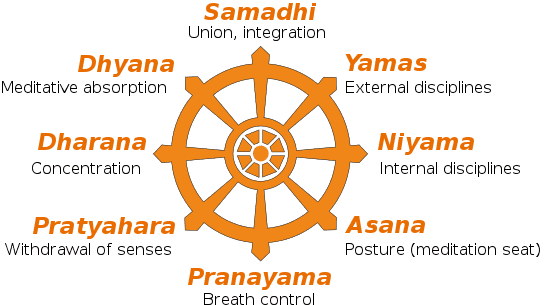
In Sanskrit “Ashta + anga” is Ashtanga. “Ashta” means Eight and “Anga” is limbs so it means Eight Limb path. Ashtanga yoga is based on Yoga Philosophy of Patanjali. It is a specific yoga tradition, but at the same time Ashtanga Yoga can be seen as covering all aspects of yoga within any yoga tradition.
Ashtanga Yoga is often called Patanjali Yoga, referring to Maharishi Patanjali, the ancient author of the famous Patanjali yoga sutras that describe Ashtanga Yoga.
The raja yoga of patanjali is divided into eight limbs and these eight limbs are interdependent and of similar value.
Classification
- Yama – the five restraints or the “don’ts”, the 5 social ethics
- Ahimsa – Non-violence
- Satya – Truthfulness
- Brahmacharya – Control of the senses and celibacy
- Asteya – Non-stealing
- Aparigraha – Non-covetousness and non-acceptance of gifts
- Niyama – the five observances or the “do’s”, the 5 personal ethics
- Saucha – Purity, cleanliness
- Santosha – Contentment
- Tapas – Austerity
- Swadhyaya – Self-study, study of scriptures
- Ishwara Pranidhana – Surrender to God’s will
- Asana – Steady posture
- Pranayama – Control of prana or life force
- Pratyahara – Withdrawal of the senses
- Dharana – Concentration
- Dhyana – Meditation
- Samadhi – Super-conscious state
It is observed that place, time, birth, etc. cause hindrances in the practice of the yamas. It is difficult to practice them without exception due to personal limitations, but it is recommended that they should be practiced universally without exceptions. Furthermore, they should be applied in deeds and words, as well as thoughts. Perfection in any of them is for the very few but much progress can be made in a given lifetime.
The Yamas
The Niyamas
Asanas
In patanjali yoga sutras, the word asana is used for the meditation posture. Asana here does not mean the physical yoga exercise. In yoga sutras its only mean for posture for meditation which can be any 4 of below given postures:
- Swastikasana
- Siddhasana/Siddhyoniasana
- Padmasana
- Sthirasana
- Sukhasna
Patanjali’s work has no other asana instruction other than the necessity of finding a posture in which to engage in the practices of pranayama and meditation.
Body and mind are intimately connected and if the body is agitated the mind will be agitated as a result. In order to meditate successfully one must develop a very steady posture. Furthermore the posture must be kept still for a long time and therefore it needs to be extremely comfortable. When the meditator is not able to control his mind, he is advised to practice the asanas of hatha yoga in order to gain the needed mastery.
But according to patanjali, asana doesn’t lead to any physical exercise but a comfortable sitting meditation posture.
Pranayama
Pra – force, prana – vital force, ayama – control or lengthening. Pranayama = pranic capacity or length. When breathing is control so as to retain the breath it is pranayama.
The raja yoga theory tells us that prana is animating the mind. Very much like the wind creates the motion of the leaves, prana creates the motion of the mind which gives rise to the vrittis. Air is the primary physical medium of prana and breathing is our best method to gain control over the prana. To meditate, the practitioner should calm his breath down until it is very shallow and even.
Serpents, elephants, tortoises, & so on live long lives because they perform the act of respiration fewer times per minute than human beings. The life of human beings can also be prolonged if breath is retained with training & practice of pranayama.
Pranayama is the cessation of inhalation & exhalation. There is neither rechaka nor puraka, there is only kumbhaka.
There are 3 types of pranayama:
- Puraka (Inhalation)
- Rechaka (Exhalation)
- Kumbhaka (Retention)
All these further divided into 2 parts called
- Antaranga (Internal retention) &
- Bahiranga (External retention)
According to Patanjali Sutras, Pranayama practice depends upon Time, place, temperature & local diet.
The fourth Type is: Keval kumbhak,
Keval kumbhak Is the purpose of pranayama and yoga practice. In Keval kumbhaka you do not have to do antaranga or bahiranga. This is exactly like Bhagavad Gita description of pranayama where it is said that apana join in prana and prana should be joined in apana, Thereby student stops incoming & outgoing sensation by joining the ingoing breath with outgoing breath.
Secondly ingoing breath should be joined with ingoing breath itself and later in final stage the student perform Kumbhak at the same time. This is how outer experiences of objects and senses left outside and inner sanskara left inside. All prana and mind stops moving.
Through this practice the psychic centers are activated & as a result cover of knowledge is removed and practitioners experience a subtler vehicle of light of wisdom within. Frequency of energy is like , that it arouses perfect stillness of thoughts and activities & no awareness of the external internal world.There is complete absence of fluctuations of brain waves, absence of conscious, subconscious and unconscious states. When prana moves through sushumna, passing through corpus callosum, one hemisphere to another, there is a state of equilibrium achieved.
Guidelines for Pranayama Practice
According to patanjali, pranayama is practiced by Desh, Kala or Samkhya. Which means environment, place, time and number of rounds. So let’s clarify this point in detail with the below guidelines
Pratyahara
Pratyahara is the withdrawal of the senses from their objects. The natural tendency of the senses is to go out towards the objects of the world. In doing so they pull the mind out and away from the inner Self and create powerful waves on the lake-mind. Therefore, the yogi must be able to pull the senses within if he is to keep a balanced and peaceful mind.
The analogy given to us is that of the tortoise which, under perceived danger, pulls in all its limbs and head.
When we turn our mind from the outer world to the inner world, we come to know that there is an infinite facet of existence in us which can only be experienced in meditation. It is not approachable through intellect. One of the great examples of Pratyahara is Yoga Nidra.
In yoga nidra when we attain the stage of disconnection of all senses from the external environment that is the fifth stage of raja yoga known as Pratyahara.
During sleep all our senses get withdrawn except channels of sound or hearing. Due to this disconnection of all senses from the external world yoga nidra serve a part of raja yoga called pratyahara.
In deeper levels of yoga nidra state of Dharana and Samadhi also achieved,
Yoga nidra is the technique which can be used to awaken divine faculties and is one of the ways of entering samadhi. In yoga nidra we use awareness of the physical dimension to build the inner vision and awareness. In yoga nidra we try to become aware about the state of subconscious and unconscious state and ultimately enter the state of superconsciousness.
Dharna & Dhyana
When the mind is concentrated on a point perception becomes intense. When the eyes are closed the object which may be a thought, an idea or a word appears intensely in the consciousness. Dharna is the practice of one-pointedness or ekagrata.
Dharna is a practice of concentration. The object belongs to a thought, an idea or a word. That means Yantra (visual form), tantra (experience), mantra (word) or visionary, subjective & objective. So concentration means confinement of mind to one point of the object.
While there is an influx of blood in the brain, there will be vibration and concentration will be difficult. To reduce the influx of blood we utilize the optic system, where students practice concentration while looking at one point with the eyes open, like trataka.
Usually when we practice concentration at beginner level we fall asleep, because concentration stops the various disturbing factors, even the psychological brain is also stopped, the cerebral activities cease for some time and during that time concentration takes place. This allows the body to go in the relaxing state and the mind falls asleep.
Concentration is not the state of forgetfulness, if we forget everything including objects, that is called shoonya, samadhi or laya. But Dharna includes awareness of at least one single object.
Samadhi
In dharna consciousness is broken, in Dhyana it is continuous, in Samadhi it becomes one with the object of concentration. Thus if you are concentrating on Aum, the symbol Aum, called Artha, will be present in samadhi, it will not vanish and will only shine in complete awareness.
In samadhi, one will not be aware about his own existence, not even the awareness that one is practicing concentration, it is a higher state of consciousness which is beyond time and space. After Dharna & Dhyana it is the third state where a student starts with dhyana and immediately goes into dhyana and suddenly enters into the state of void. This is the first stage of samadhi where you remember the object but there is no other awareness, consciousness becomes one with the object.
Fourth State – Samyama
Samyama is the fourth state of inner practice of concentration where one becomes a master of psychic process and having complete control of mental concentration.
Samyam performs on a single object with three processes of concentration. The samyama starts with subjective and objective awareness; that is a dual awareness. One is aware of the object of meditation within, as well as in the outside world, gradually outer doors are closed & you see only the thing that is inside, that is dhyana. Then the thing seen inside becomes clearer and clearer and simultaneously you lose your personal consciousness that is called samadhi. The three are put together known as samyama.
Final State – Nirbija Samadhi
Nirbeeja samadhi is the innermost and finest state of samadhi. Yama, Niyama, Asana, Pranayam, Pratyahara are external for Dharna, Dhyana & Samadhi, and now the state of Dharna, Dhyana, Samadhi and Samyama are also external for Nirbija Samadhi, because it is the deepest and inner most layer of consciousness.
In nirbija samadhi there is no object or pratyay, no seed but pure consciousness. Sabeeja samadhi(samadhi that carries objects in consciousness) is external to nirbija samadhi. Although one can obtain supernatural power through samyama but it is not the highest state, the highest state of nirbija samadhi is completely different. Sabeeja or samyama can be performed on present object or past object like previous birth but any samyam is external to nirbija samadhi.
Through ekagrata parinama (one-pointedness) one tries to continue the pratyay & maintain the state of sabija samadhi. One transcends the seed of sabija samadhi through nirodh parinam (voluntarily dropping of pratyay) and establishes a state of void or shoonyata called Nirbija Samadhi.
What Is Kundalini?

Kundalini Yoga: An occult superstructure to which Hatha Yoga may lead those who fall inclined to go that way is called Kundalini Yoga. Kundalini yoga is a form of yoga that involves chanting, singing, breathing exercises, and repetitive poses. Its purpose is to activate your Kundalini energy or shakti.
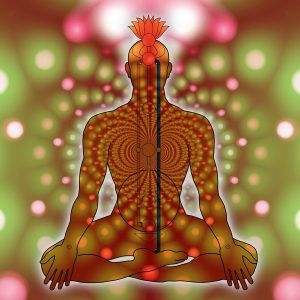
Kundalini Yoga is part of the tantric tradition. Tantra says that the range of mental experiences can be broadened. Based on senses the mental experiences are limited to time, space, and object, but there can also be an experience that is beyond the framework of time, space, and object. Therefore the tantric and yogis have realized that there is a potential force that is not physiological, philosophical, or transcendental. It is a dynamic potential force in the material body called Kundalini. Kundalini yoga is not abstract. It considers this very physical body as the basis. The kundalini yoga represents consciousness as the highest possible manifestation of physical matter in this body. The physical matter of the body transformed into subtle forces like – feeling, thinking, reasoning, etc for the process of evolution. The psychic and transcendental power is the ultimate goal of human evolution.
As Kundalini yoga awakens kundalini energy, it’s supposed to enhance your awareness and help you move past your ego. Sometimes, the practice is also called “yoga of awareness.” Kundalini yoga is also more precise and repetitive. Whereas other types of yoga flow with your breath, Kundalini yoga combines chanting, singing, movements, and breathing in specific patterns.
In 1968, Harbhajan Singh Khalsa, also known as Yogi Bhajan, introduced his own brand of kundalini yoga into the United States, “Kundalini Yoga as taught by Yogi Bhajan”. Yogi Bhajan founded the “Healthy, Happy, Holy Organization” (3HO) as a teaching organization. Yogi Bhajan took yogic postures and techniques, attached them to Tantric theories and Sikh mantras, synthesizing a new form of ‘Kundalini’ yoga.
Kundalini yoga possesses a clear knowledge of 6 chakras. Detailed knowledge of Nadis psychic nerves for carrying prana & chakras is necessary for a student who is treading the path of Kundalini Yoga.
Kundalini yoga consists of six main components, which are done in the following order:
- Opening chant. Every class begins with an opening chant, also known as tuning in.
- Pranayama or warmup. You’ll do breathing exercises, called pranayama, and sometimes also movements to stretch your spine. The goal of pranayama is to practice breath control.
- Kriya. A kriya is a sequence of postures, pranayama, mudras (hand positions), sounds, and meditation. The length and intensity of the kriya depend on your instructor.
- Relaxation. This allows your body and mind to absorb the effects of a kriya.
- Meditation. Your instructor guides you through meditation to cultivate awareness.
- Closing chant. The class ends with a closing chant.
What is Kriya Yoga?
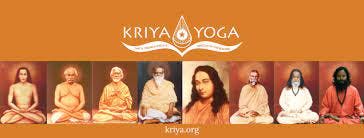
Kriya Yoga, as taught by Lahiri Mahasaya, is traditionally exclusively learned via the Guru-disciple relationship and the initiation consists of a secret ceremony. He recounted that after his initiation into Kriya Yoga, “Babaji instructed me in the ancient rigid rules which govern the transmission of the yogic art from Guru to disciple.”
As Yogananda describes Kriya Yoga, “The Kriya Yogi mentally directs his life energy to revolve, upward and downward, around the six spinal centers (medullary, cervical, dorsal, lumbar, sacral, and coccygeal plexuses) which correspond to the twelve astral signs of the zodiac, the symbolic Cosmic Man. One half-minute of revolution of energy around the sensitive spinal cord of man affects subtle progress in his evolution; that half-minute of Kriya equals one year of natural spiritual unfoldment.”
The process of performing Kriya Yoga is claimed to lead to a certain purification of the blood which frees up the life force to withdraw into the spine. “Kriya Yoga is a simple, psycho-physiological method by which the human blood is decarbonized and recharged with oxygen. The atoms of this extra oxygen are transmuted into life current to rejuvenate the brain and spinal centers.
Kriya is a process of converting breath into lifeforce and realizing the body as light. In Kriya Yoga, when you inhale and exhale continuously, oxygen is quickly converted into life energy that recharges the entire body, especially the blood and the lungs with vital sustenance.
The Kriya yoga system consists of a number of levels of pranayama, mantra, and mudra based on techniques intended to rapidly accelerate spiritual development and engender a profound state of tranquility and God-communion
Kriyas are possibly the most efficient method for systematically evolving man’s consciousness that has ever been developed. They are said to have been the teachings for the transcendental sadhna which Lord Shiva gave to his disciple & wife, Parvati.
What is Mantra Yoga?

Mantra is a syllable, word or phrase endowed with special power, usually drawn from ancient scriptures.
According to Patanjali, Mantra meaning is the designation of supreme consciousness in form of sound. Where Yantra is the psychic figure and Mandala is the human symbol, like the statue of God.
According to Tantra, Mantra is the sound form of Deity, which is the power of consciousness that is the main propulsion toward realization. Each deity has a specific mantra, which is its mental form. Deities have single seed syllables or bija mantras, like Om for Tara and an extended mantras, which may contain the name of deity along with various words. Each deity also has various Vedic & puranic verses or mantras that can be used in its worship.
Mantra yoga is a type of yoga that uses mantras to awaken the Self and deepen the meditative aspects of a physical yoga practice. Mantra yoga is an exact science that is meant to engage the mind by focusing on Mantra Sound, and a number of repetitions. Repetition of the mantras is a means to get closer to the divinity within, and it creates positive vibrations that benefit both the one who chants and the one who listens.
Mantra yoga may also be referred to as Japa yoga. Japa is a Sanskrit word for the act of repeating mantras. Working with sound whether as mantra, music or vibration is central to the energization of the Mind. According to Vedas, at the beginning of the universe, the only thing that exists is a word or a vibration that is OM.
Speech has several levels of manifestation, which are the keys to the nature & function of Divine within and the movements of our own minds and hearts.. Vedas recognizes 4 levels of speech,
| Name | Speech | Location | State |
| VAIKHARI | Audible speech | Throat | Waking State |
| MADHYAMA | Thought | Heart | Dream State |
| PASHYANTI | Illumined Speech | Naval | Deep Sleep |
| PARA | The transcendent | Root Center | Samadhi |
Vaikhari refers to the course or literal level of speech. Most of the time our minds stay on this level of audible speech and conventional meanings enter into Madhyama, which literally means Middle level, when we think deeply about something, when we ponder or wonder about things. Most artistic thinking comes from this level, which reveals the beauty of form & has a creative force. The third level, Pashyanti or the illumined word, occurs when we perceive the underlying cosmic truth or archetype behind the object or event. Its nature is light or revelation & it reveals the seed forces at work in the universe. We only reach this level through deep meditation.
The fourth level is Para, the level of pure silence wherein meaning is so full & complete that it cannot be broke down into words. This is the level of pure consciousness, the Divine Word Of Silence: “I am All”.
The power of speech must be brought down to the base of the spine to allow the energy of consciousness to ascend upward as Kundalini to awaken our higher potentials. Before our consciousness ascends our energy must first descend and penetrates to the depths of our being. To bring the power of speech inward & down is the work of Mantra Yoga. To bring speech downward, the breath along with the sound current of the mind must be brought down to the corresponding center of the subtle body.
Guidelines for Mantra Chanting
- Chant the mantra with a sattvic, or pure, mind, which implies a peaceful intention and a calm frame of mind.
- Follow a sattvic lifestyle, including a vegetarian diet. Refrain from negative emotions, take time in solitude and make your life a form of service.
- Honor the Divine power connected to the mantra before starting your practice, whether through mental acknowledgment, some form of ritual, or through a representative form like a statue or picture.
- Get the knowledge or Mantra diksha from a Guru for the better effect of mantra on Mind.
- Make sure to pronounce the mantra properly. For this you may need to learn the basic rules of pronouncing the Sanskrit alphabet.
- Initially chant the mantra out loud to gain a sense of its sound pattern. Then chant it softly on the breath to connect it to the prana. But most chanting will be mental, while you are silent outwardly.
- Chant the mantra in a regular manner at a certain time of day for a certain number of times.
- For counting mantras, it is best to use a mala, or rosary, of 108 beads.
Benefits Of Mantra Yoga
- The basic and general ways of improving concentration
- Improve awareness and develops a positive attitude.
- Provides a sense of discipline if practice regularly.
- Regular and Consistence practice of Mantra Japa, open the deeper realm of consciousness and helps to attain the state of bliss.
What is Nada Yoga?

‘Nada’ is the sanskrit word which means the sound or tone or vibration or stream or river. Hence, Nada represent the internal object of “sound stream” as the object of meditation. According to physics, the whole world is nothing but a vibration or energy. Everything is vibrating and everything is sound. The training of Nada Yoga is found in the oldest religious text called Rig-Veda where we found Nada-Bindu Upanishad, which teaches meditation on the nada or The Inner Sacred Sound.
Nada Yoga is the Yoga of listening. It is the way to turn inward on a journey that leads to the awakening. According to Nada yoga sound is more than what is heard through ears, it is an internal sound that is far beyond our senses, by focusing our mind on this internal sound we reunite with our inner being and experience bliss in both body and mind.
The meaning of Bindu is nboth physical and metaphysical that means, a point, a drop, or a dot. We generally understand Bindu as the point of concentration power. It is also the potential for creation. it is the point at which the capacity for the unmanifest to become manifest is realized. By Nada yoga Practice, we realized that Bindu is a portal through which we find the Nada and reconnect our individual consciousness with universal consciousness.
Laya yoga, the “yoga of mergence,” involves meditation on the inner sound current, called nada, which arises when the mind becomes pure and clear. We can hear this vibratory sound if we close our ears and listen deeply with attentive awareness. Swami Sivananada, describes Laya as “the state of mind when one forgets all the objects of the senses and becomes absorbed in the object of meditation. Laya enables one to have perfect control over five sense and mind. In laya yoga the fluctuations of mind stops and prana will be entirely subdued.” He states that “the experience of ecstasy created by the process of laya yoga is none other than moksha or samadhi.”
There are many types of nada that exist. These are said to be like the sounds of a bell, a drum, a flute, the ocean, or other sounds. Nada is the celestial music within us. We hear these sounds with our inner ear, the subtle counterpart of our gross organ of hearing. They reflect the sound of the cosmic intelligence inherent in space, which is the source of all knowledge.
Nada is the inner power behind the mantra. The outer mantra works to awaken the inner nada. Then the nada repeats the mantra, which is held in our inner sound current. The nada itself can assume the form of the mantra. This indicates that the mantra is resonating with our inner being.
To meditate upon the nada is not just to listen to or to repeat a sound. It is also to inquire into the origin of sound, to follow the sound current back to its origin. This is to inquire into the origin of our own consciousness, which itself is a manifestation of sound. It is to contact our inner Self in the spiritual heart from which the sound current arises.
All forms of spiritual music come under the Yoga of Sound if we follow their vibrations back to the Divine Word within us. This includes vocal and instrumental music in all their beauty and diversity. Music, in turn, may be allied with poetry, drama and dance. Poetry is a kind of verbal music. Drama is the enactment of poetry. Dance is its expression. The internal usage of music can energize the various chakras that reflect the music of our soul.
What is Patanjali Yoga?
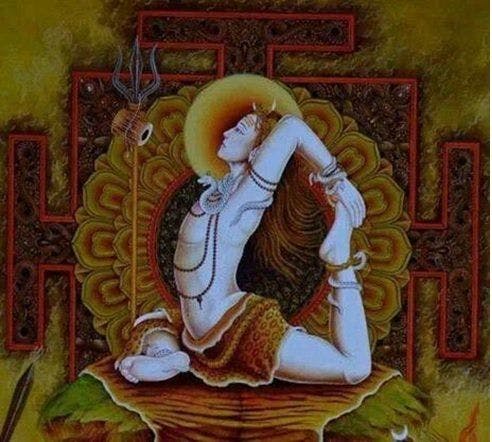
The Yoga Sutras of Patanjali is a collection of Sanskrit sutras (verses) on the theory and practice of yoga – 195 sutras (according to Vyāsa and Krishnamacharya). The Yoga Sutra was compiled sometime between 500 BC and AD400 by the sage Patanjali in India who systemize & documented that time knowledge of Yoga & its benefits for the complete human race.
Patanjali Yoga is a system that consists of eight stages: yama, niyama, asana, pranayama, pratyahara, dhrana, dhyana, samadhi, it is therefore widely called ashtanga yoga, the yoga of eight stages.
Yoga Sutras has its roots based on the Samkhya Philosophy, which is said to have been formulated by Rishi Kapila. The samkhya system dispenses with all theories of God; it says that the existence or non-existence of god is irrelevant to personal sadhna, spiritual practice. Buddha said the same thing he taught neither belief nor disbelief in God. Sage Patanjali, on the other hand, differs from both Samkhya & Buddhism as he introduces the concept of God, with the powerful means of sadhna & Ishwar Pranidhan where he described them as the practices of self-realization for those inclined towards the path of Bhakti Yoga.
All the techniques of Raja yoga existed long before sage patanjali, even in a latent seed form within the collective unconscious mind. The Yoga Sutras are probably a compilation of previously known verses handed down from guru to disciple by word of mouth. It was the genius of someone called Patanjali who put the system into a comprehensive written whole.
The Patanjali Yoga Sutras is the most precise and scientific text ever written on yoga. It is divide into four chapters:
Samadhi Pada: Consisting 51 verses. Samadhi refers to a state of supreme being where the yogi’s self-identity is absorbed into pure consciousness, collapsing the categories of witness, witnessing, and witnessed. Samadhi is the main technique the yogi learns by which to dive into the depths of the mind to achieve Kaivalya (liberation). The author describes yoga and then the nature and the means of attaining samādhi.
Sadhna Pada: Consisting of 55 verses. Sadhana is the Sanskrit word for “practice” or “discipline”. Here the author outlines two systems of Yoga: Kriya Yoga and Ashtanga Yoga (Eightfold or Eight Limbed Yoga).
- Kriya Yoga in the Yoga Sutras is the practice of three of the Niyamas of Ashtanga Yoga
- Tapas– austerity
- Svadhyaya– self-study of the scriptures
- Ishwara Pranidhana – devotion to god or pure consciousness
- Ashtanga Yoga is the yoga of eight limbs:
- Yama – restraints or ethics of behaviour
- Niyama– observances
- Asana– physical postures
- Pranayama– control of the prana(breath)
- Pratyahara – withdrawal of the senses
- Dharana– concentration
- Dhayana– meditation
- Samadhi– absorption
Vibhuti Pada: consisting of 56 verses. Vibhuti is the Sanskrit word for “power” or “manifestation”. ‘Supra-normal powers’ (siddhi) are acquired by the practice of yoga. Combined simultaneous practice of Dharana, Dhyana, and Samadhi is referred to as Samyama, and is considered a tool of achieving various perfections, or Siddhis. These powers can become an obstacle to the yogi who seeks liberation.
Kaivalya Pada: Consisting of 34 verses. Kaivalya literally translates to “isolation”, but as used in the Sutras stands for emancipation or liberation and is used where other texts often employ the term moksha (liberation). The Kaivalya Pada describes the process of liberation and the reality of the transcendental ego.
What is Hatha Yoga?

Hatha Yoga: Prostrating first to the Guru, Yogi Swatmarama instructs the knowledge of Hatha only for the highest state of Yoga. It is also emphasized the hatha yoga is to be practiced for the sole purpose of preparing oneself for the highest state of Raja Yoga i.e. Samadhi. – Swami Swatmaram
Hatha yoga definition defines as the union of the sun and the moon, the physical and mental energies, prana shakti, and Chitta shakti. The basic principle of hatha yoga is the harmonization of this dual-energy which governs the functioning of the physical body and its organs, and our mental activities, reactions and moods. Hatha yoga deals with these energies through the swaas i.e. the flow of breath in the nostrils, and through the two major nadis, ida and pingala, the energy channels corresponding to the right and left nostrils, body’s right and left halves, and brain’s two hemispheres. When the energy of the two halves become equal i.e. in a third force,known as atma shakti or kundalini shakti dawns.
Hatha Yoga Benefits
The main benefits of Hatha yoga practice are:
- Restores and maintain good health, by reestablishing the fundamental balance in the physical and energetic frame work
- Avoids the illness factors, mainly disturbances blockages which decreases prana Shakti i.e. vital energy flow
- Influences the mental realm because a healthy and quiet body has a psychosomatic effect; it reduces dissipations, conflicts, lack of confidence existing in the mind.
Hatha yoga comprises Asanas or postures, pranayama or breathing practices, shatkarmas or cleansing exercises, bandhas/energy locks, mudras or somoto-psychic gestures
Hatha yogis in the past, practiced mainly the shat karmas, the yogic cleansings, but gradually, encompassed different types of posture and other techniques.
Hatha yoga is considered as a pre-requisite and complements to raja yoga and kundalini yoga. Swami Swatmarama introduced Hatha yoga. Hatha yoga is the union of opposing forces.
Hatha Yoga Pradipika
According to ‘Hatha Yoga Pradipika‘ – the main text based on Hatha Yoga by Swami Swatmaram, the main components of Hatha Yoga are:
Jnana Yoga
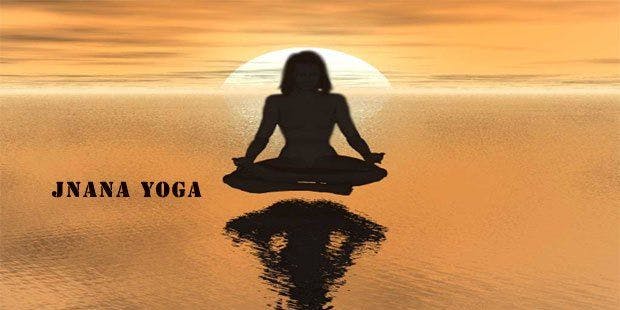
The word ‘jnana’ means knowledge. Knowledge is viewed by the Hindu scriptures as both liberating and binding. Knowledge is viewed as the means to achieve certain ends. It can be used to fulfill our desires or liberate ourselves from the cycle of births and deaths.
The knowledge that helps us realize our selfish desires and perpetuate our limited identities is considered lower knowledge. It is also termed as avidya or ignorance. The knowledge that helps us overcome our egoistic attitude and desires and realize who we are is considered higher knowledge or the real knowledge.
Real knowledge liberates us from the three impurities of human existence, namely egoism, desire ridden actions and the illusion that we are different from the rest of the world and that the objective reality which we experience through our senses is real and permanent.
Janana Yogais the type of self realization. This process involves the higher wisdom or final direct realization of the essential unity of existence.
Jnana yoga is therefore the pursuit of true knowledge by learning how to control our minds and senses and center ourselves in our spiritual selves so that we can become free from our bondage to the cycle of the births and deaths and achieve liberation.
The Bhagavadgita identifies jnana yoga as one of the three main paths to liberation, the path of knowledge, the path of action and the path of devotion. While the path of devotion is described as superior to the other two, jnana yoga is suitable for people who are deeply intellectual. On the path of liberation it is important to possess right knowledge, which comes through the study of the scripture and helps us understand the significance of other yogas such as karma yoga, sanyasa yoga, buddhi yoga, atma samyama yoga, and bhakti yoga.
Janana Yoga is the process of direct experience not to know the result conceptually. Thus janan yogi too reaches that some supra-state in which he becomes identified with all living beings amidst which he lives and moves about, he becomes a lighthouse for illuminating the path for the ship of human life that is caught in turbulent sea of endless conflicts & tensions, to the safe anchorage of limitless peace & bliss.
Janan Yoga is the path of intellect. The way of logical faculty is called Buddhi. We use the power of discrimination of janana yoga to get the reality. The purpose of jnana yoga is to achieve liberation by realizing our true nature, overcoming our ignorance and transcending our limited selves, which are sense dependent and bound by karma. According to the Bhagavadgita, following are some of the developments that we experience when we practice jnana yoga.
- Equanimity of the mind (sthithadhi) through control of the senses and desires and mental discipline.
- Detachment (asangatva)
- Impassion (virag)
- Tyaga (sacrifice)
- Renunciation (sanyasa)
- Self-control (samyama).
- Devotion (bhakti).
The second chapter of the Bhagavadgita is known as Jnana Yoga or Samkhya yoga. According to some scholars it is a summary of the Bhagavadgita itself since it contains all the important concepts and ideas of the scripture. It reminds us that we should not identify ourselves with our minds and bodies as we are immortal, spiritual beings and that to transcend our limited nature we have to gain control over our sense organs and our desires through detachment and equanimity and work for our salvation by performing actions for the sake of God. According to the Bhagavadgita, jnana yoga consists of the following practices.
- Developing correct awareness of the mind, the body and the Atman or Self.
- Stabilizing the mind in the Self through self-discipline and self-absorption (atma-samyamyoga)
- Acquiring true awareness of the world around and the SUPREME-Self beyond (knowledge of Sat (Truth) and Asat (Falsehood) through discernment (buddhi yoga).
- Practicing various disciplines and other techniques as a means to self-purification, the predominance of sattva and suppression of rajas and tamas..
Perfection in jnana yoga leads to devotion. Only a jnani, or the knower of the Self, can be a true devotee. People who do not possess true knowledge of the Self, cannot experience the devotion of the highest kind, which the Bhagavadgita extols in several verses. Since they not yet fully free from desires and attachments their devotion remains tainted with traces of selfishness and the impurities of rajas and tamas. When the heart and minds are pure, filled with the effulgence of sattva, true devotion arises in them.
knowledge of God and Self
The Bhagavadgita suggests various alternatives regarding the regaining of knowledge. Its emphasis, however, is on self-purification and cultivating discernment. In the seventh Chapter, Lord Krishna explains two types of knowledge. One is the knowledge of God and Self (para) and the other is the knowledge of Nature or his lower Self (para). True knowledge according to the scripture is the knowledge of the Self, or the knowledge that leads to liberation. It is acquired in one or more of the following ways. They are all aspects of self-purification, whereby the impurities surrounding the Self are cleansed and removed and the mind becomes sharp.
Karma Yoga

Karma yoga is the yoga of action. It’s about purifying your heart by learning to act selflessly in service of others. Through karma yoga we learn kindness and compassion without an expectation of gain. The idea being that learning these lessons helps us to step away from our ego, freeing us to move one step further on the path to enlightenment.
Service can be a powerful means of releasing yourself of your ego, learning to act from pure intentions, and connecting with the bigger picture. Service is at the heart of karma yoga and it is this belief in the power of karma yoga and the importance of giving back that is at the core of our company.
Karma has been recorded in 3 categories:
- Kiyaka (bodily Actions)
- Vicika (verbal/words)
- Manasika (Mental/Thoughts)
Classification of Karmas
Further classification of Karmas comes under any of upper classified categories are
2 kinds of Bhav
2 kinds of Bhav included in karmas :
3 categories of Karmas
There are 3 categories of Karmas for fruits:
- Sanchita: Accumulated karma, which are yet to bear fruits of previous karmas. These are the accumulated works and actions that you have completed in the past. These cannot be changed but can only wait to come into fruition. This is the vast accumulation of karma that encompasses our countless past lifetimes. This comprises every action that you have ever made in your past and present lives.
- Prarabdha: Previous Karmas, which gave rise to the present incarnation. That we are bearing in present. Prarabdha is that portion of the past karma that is responsible for the present. These are the ripe and fructuous actions and reactions. The things that you did in the past make you what you are today. It cannot be avoided or changed, but only exhausted by being experienced.
- Agami: Current actions which will fructify in future. The actions performed by Jivanmukta or an enlightened person also termed as Agami Karma. Agami Karma is the Karma we are creating for ourselves right here in the current moment. It is the action that we create and the choices we make right now, as we live this present lifetime.
Difference between Karmas of Ordinary People & Karmas of a Yogi
The ordinary people operate through lower mind & senses, & mind & body are the vehicles of karma. When karmas are performed through indriyas, mind & body they bring about 3 fold effect: good karma, bad karma, mixed karma and hence continue with the cycle of birth and death.
Whereas a yogi does not operate through lower mind; they operate through nirman chitta. They perform samyama on previous births, manipulate the forces of higher planes and create artificial minds with different consciousness simultaneously. Through these artificial minds the yogi operates in different spheres of his all consciousness at same time. He is in full awareness of all chittas simultaneously. This is done by samyama on mahatattwa (ahamkara & asmita). The created mind give him experience of fruits of his previous births or samskaras, These experiences are transferred to natural mind of yogi and that mind becomes free of karmashaya due to enjoyment of its fruits and hence yogi becomes free from samskaras and free from cycle of birth & death.
Yogis act in such a way that his karma cannot be classified as good or bad or inaction. Because the mind of yogi is clarified through sadhna and thus he has no selfish motive underlying his actions he becomes neutral towards consequences and hence he will be free from all upcoming fruits of karmas.
Yogis are able to operate different minds, in different bodies and different places, and they also do karmas. The impressions are wiped out from the natural mind and it becomes progressively free of its karmashaya. He is now free from all sanchita, prarabdha and agami.
Bhakti Yoga
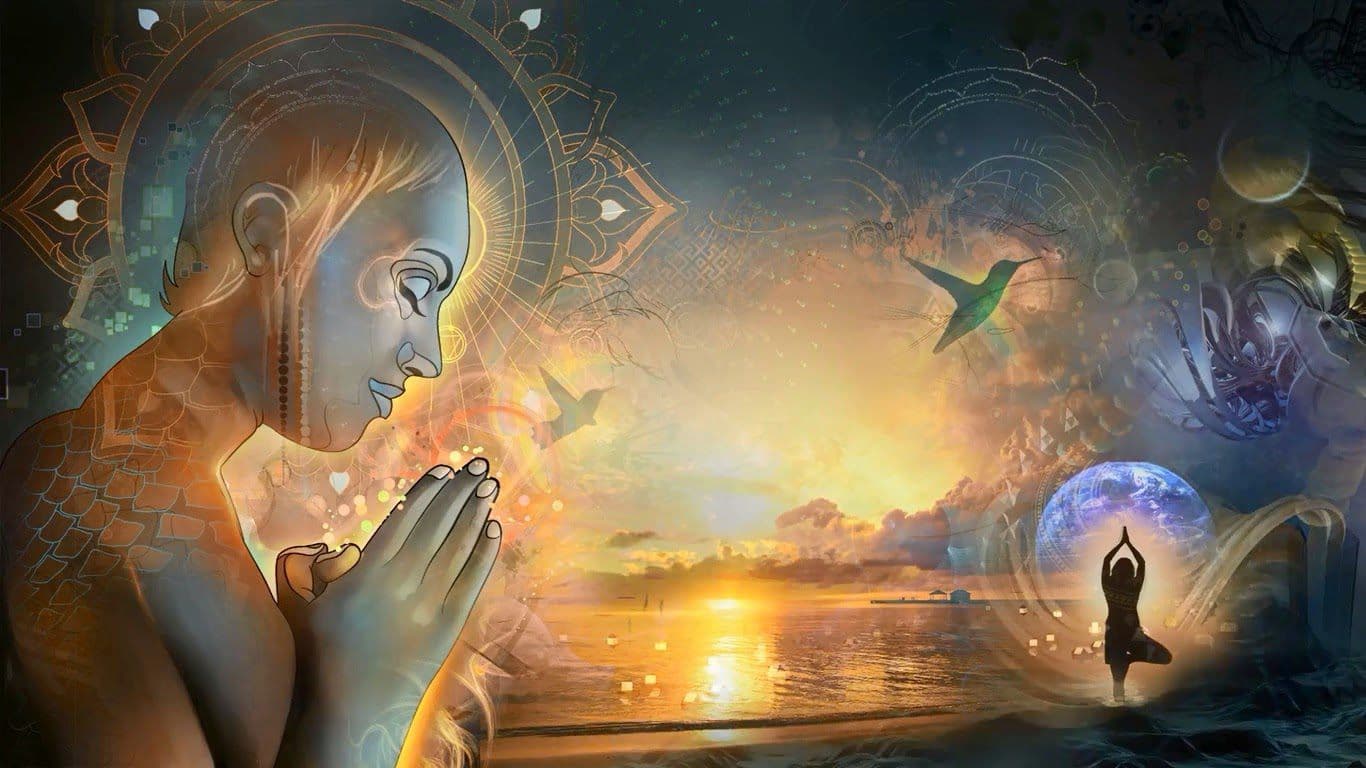
According to Patanjali, Bhakti yoga is the easiest path for those who are emotionally & devotionally inclined. One of the easiest ways to understand the path of bhakti and expand our devotional attitude is to treat others the way we would like to be treated.
A realization that everything is the Supreme Consciousness, nothing else exists. Losing the sense of separateness from that all-pervading Power, losing the identity that is defined by the world, and merging, diving into the vast, endless ocean of a throbbing, all-encompassing Infinite Love. Bhakti Yoga is the lively feeling of oneness with that Spirit.
Bhakti is not about seeking that love but dropping the barriers we have built within, against it. It opens the door to eternity, within us. It is the love that shines in our eyes as the light of our souls. Bhakti wakes us to realize that everything is a reflection of the Divine.
In Bhakti, one can experience total freedom from fear and worry. A devotee transcends worldly sorrows and pains.
A pure devotee has no selfish desires, including the desire for liberation. Bhakti in one’s heart is kindled by the grace of the Guru, by being in the company of other devotees, and by reading and listening to the stories of other “bhaktas” or devotees.
The tradition has ancient roots. Bhakti is mentioned in the Shvetashvatara Upanishad where it simply means participation, devotion, and love for any endeavor. Bhakti yoga as one of three spiritual paths for salvation is discussed in depth by the Bhagavad Gita.
Bhakti marga is a part of the religious practice in Vaishnavism, Shaivism, and Shaktism
Bhakti yoga is one of three yoga taught in the Bhagavad Gita. Bhakti means we must surrender to Krishna alone. We all have a natural and original transcendental relationship with Lord Krishna. To engage in that relationship under the guidance of a bonafide spiritual master is called bhakti or devotional service. Bhagavad Gita is the dictionary and Srimad Bhagavatam is the encyclopedia to properly understand the process of bhakti-yoga.
Aarth Bhakt: The Bhagavad Gita, recognizes four kinds of devotees who practice Bhakti yoga. Some practice it because they are hard-pressed or stressed by anxiety or their life circumstances and see Bhakti yoga as a form of relief.
Jigyasu Bhakta: The second type practices Bhakti yoga to learn about god out of curiosity and intellectual intrigue.
Artharthi Bhakta: The third type seeks rewards in this or in the afterlife through their Bhakti yoga.
Gyani Bhakta: The fourth are those who love god driven by pure love, knowing and seeking nothing beyond that experience of love union.
According to these Hindu texts, the highest spiritual level is the fourth, those who are devoted because of their knowledge of love. The Bhagavad Gita states that all four types of Bhakti yogi are noble because their pursuit of Bhakti yoga sooner or later starts the journey on the path of spirituality, it keeps one away from negativity and evil karma, it causes spiritual transformation towards the goal of Bhakti yoga.
Types
...

